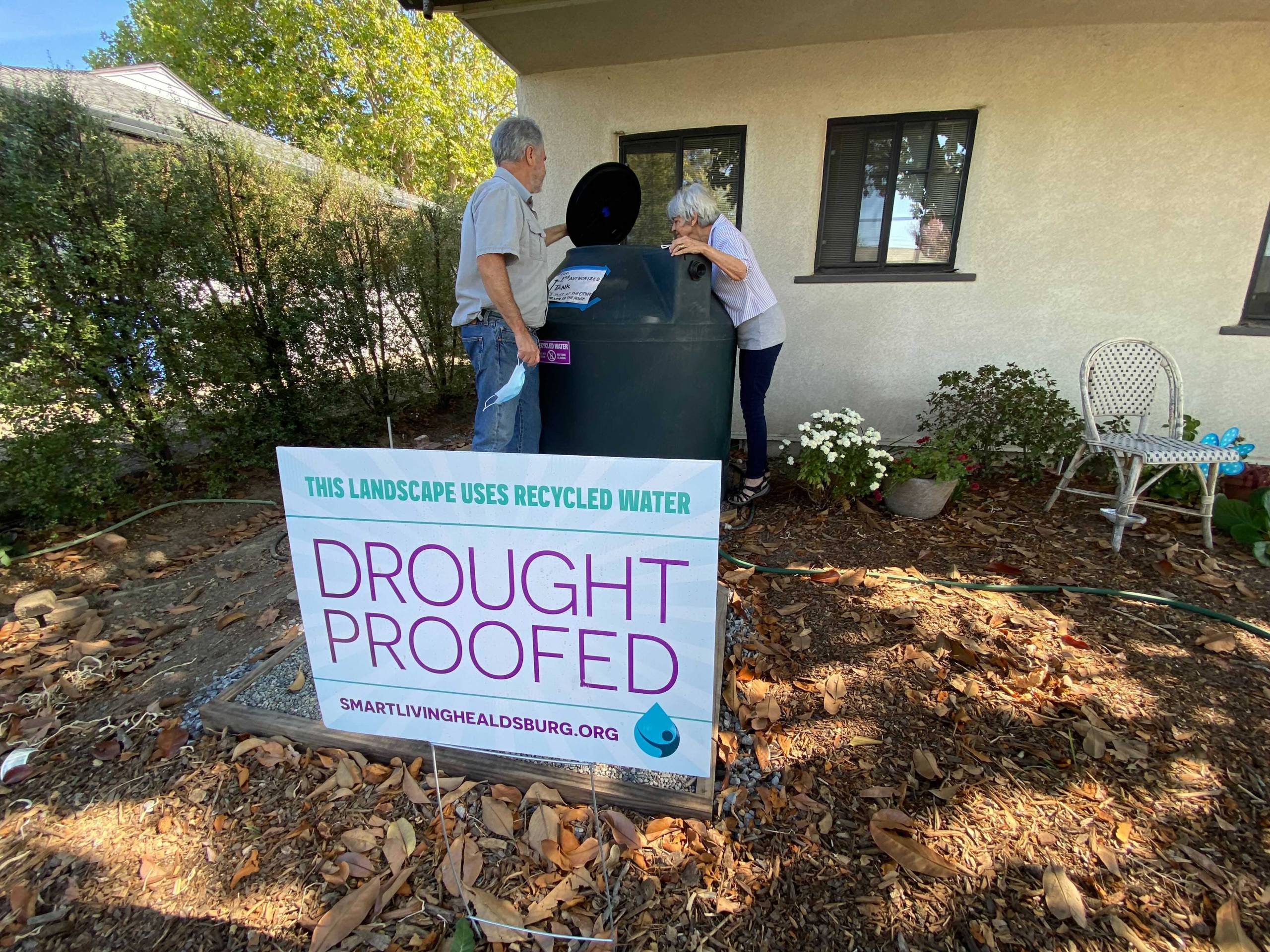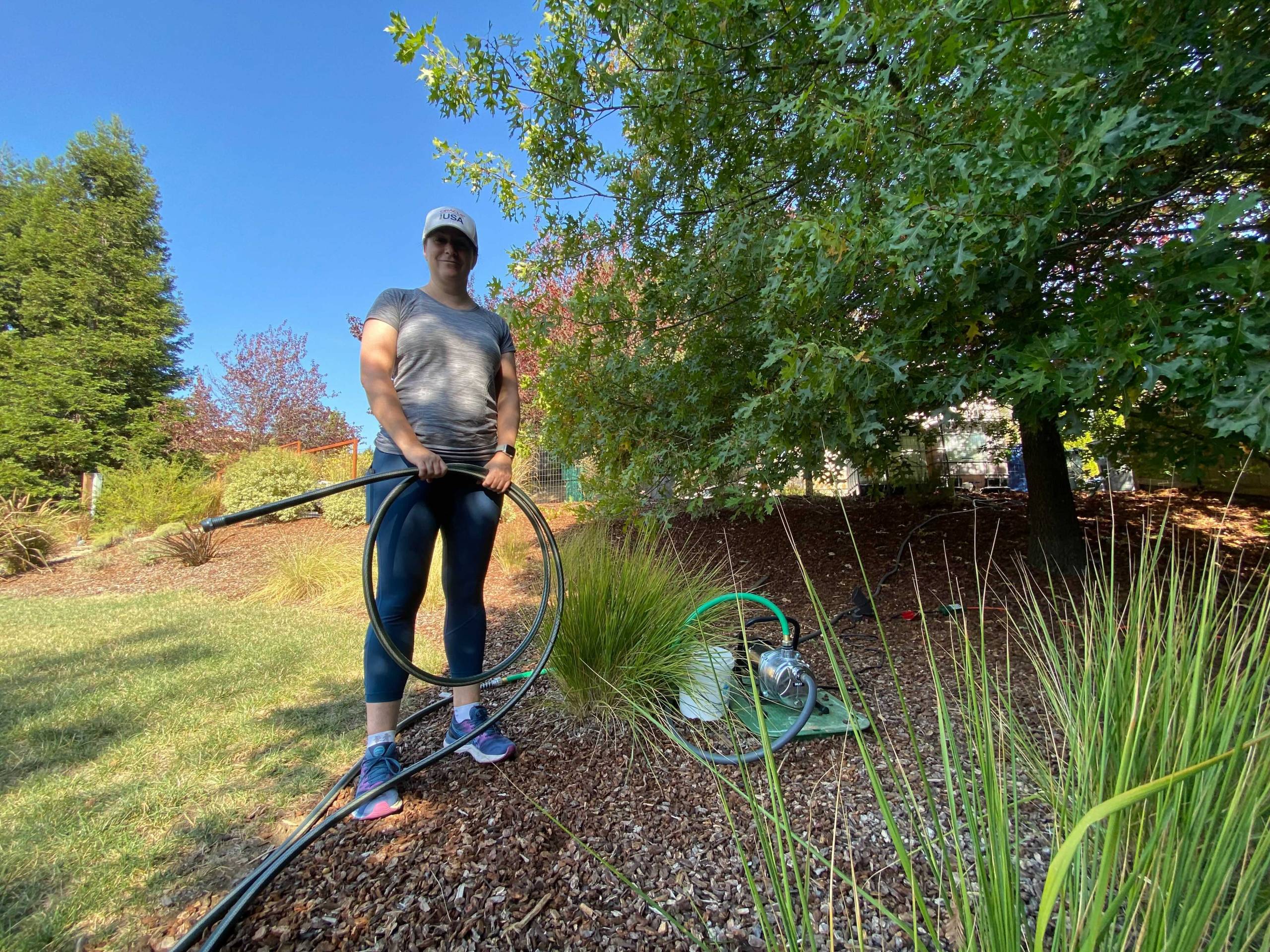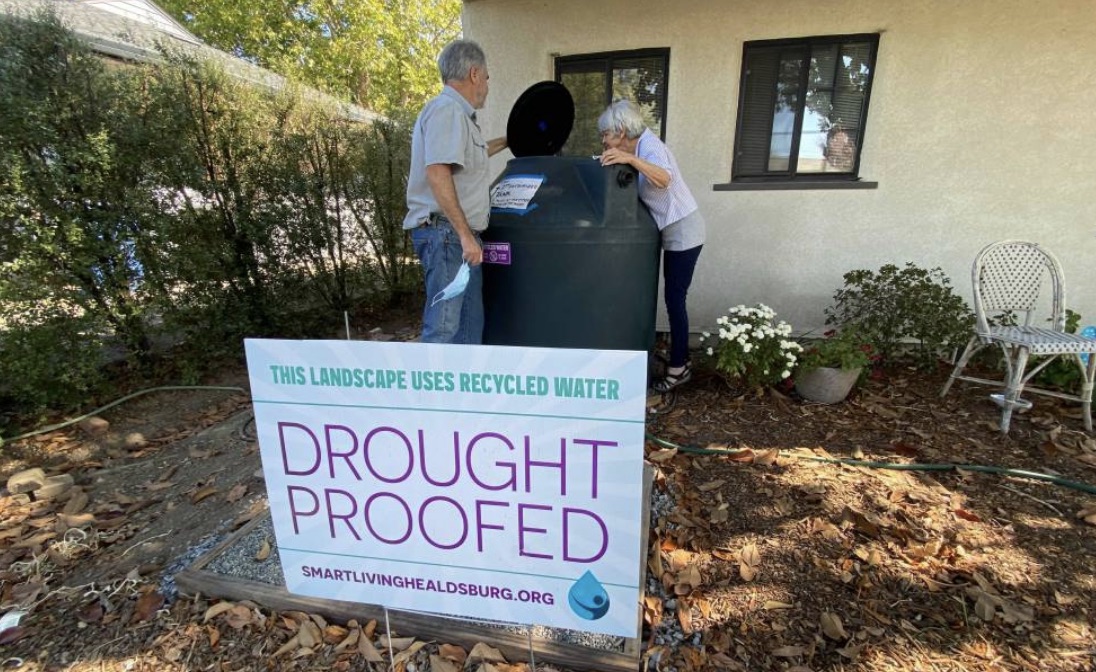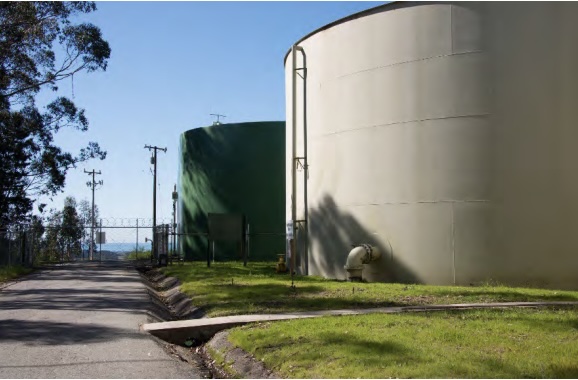|
Getting your Trinity Audio player ready...
|
KQED POST. “Healdsburg Cut its Water Use in Half. What’s in the City’s Secret, Water-Saving Sauce?” By
Listen as Podcast
Wearing a faded green collared shirt tucked into equally worn blue jeans, Diniakos said he now limits his showers to “once every other day, sometimes every three days.”
He doesn’t want to, but he’s doing it. “I would rather take a shower every day,” he said. “It just feels better.”
Even so, Joyce says she’s winning their water war because she does “laundry much less often.”
Among a maze of potted succulents beneath a broad magnolia tree in the couple’s front yard is a sign that reads: drought proofed.
Diniakos and Joyce live in Healdsburg, in Sonoma County. These signs are everywhere around town, the city gave them to residents who participated in its water saving program. Just like the rest of the state, Healdsburg is gripped by drought. But the city is conserving at a much higher rate than California overall.

Healdsburg nearly cut its water use in half in August, compared to the same time last year. Californians overall saved just 5%, and that’s after Gov. Gavin Newsom asked everyone to voluntarily reduce their water use by 15% back in July.
Newsom declared a drought emergency across the entire state this week, as conservation targets continue to fall far short.
So, what’s in Healdsburg’s secret, water-saving sauce? The city capped household water use and banned sprinklers. And residents largely followed the rules — no surprise there, the signs of drought are everywhere. A pencil-thin band of the Russian River flows from Lake Mendocino through town. Crunchy front lawns with yellow grass dot the community of 12,000 people.
“We were in a dire situation,” said Joyce. “People got that and wanted to do the right thing.”
The couple practically lives out of buckets in an effort to save, watering plants and soaking greasy pans using grey water.
They tracked how much water they used brushing their teeth and showering with a phone app that pulls data from a sensor connected to their meter, which Joyce said “made it fun.” She could see how much water they wasted in real time and discovered there’s always an opportunity to “turn the volume down a little bit.”
All that conservation worked, the couple averaged 24 gallons a day this summer and fall; incredible, and well below the city’s allotment of 74 gallons per person, which is about half of what a person in Healdsburg normally uses.
A system in crisis
What makes Healdsburg’s situation unique is that the Russian River system, starting high in the coastal range and flowing to the ocean, is in crisis. The river sits isolated from the rest of the state. There are no canals or aqueducts connecting it to the state’s vast system of waterways or the meltwaters that originate high in the Sierra Nevada.
Unlike much of the Bay Area, the only water Healdsburg gets is from rain.
Lake Mendocino is now just 22% full and for much of the summer it resembled a muddy bathtub. The city saw that the lake levels were depleted and it prompted them to save, said Terry Crowley, the city’s utilities director.
“The rainfall totals were the lowest in 100 years,” said Crowley. “We really need to see some rain this winter or it’s going to be very difficult next summer.”
A series of rainstorms are soaking Northern California this week, with most of the precipitation falling across the North Bay. The badly needed showers could help the reservoir bounce back, but it won’t end the drought, not by a long shot. That will take several months of wet weather.
‘Lawns should be banned’
Many people in Healdsburg have large yards, and the city took a risk by cutting off water to lawns. But as climate change gets worse and droughts become more frequent, Crowley envisions the city will look very different.
“[What] I would expect to happen over the next 10 to 15 years is a lot of those lawns would be changed out to drought-tolerant plantings,” he said.
Crowley says around 10% of the city’s residential customers already have swapped their lawns for drought-resistant shrubs, succulents and cacti. Many more have let their lawns become dry and brittle. To help residents, the city offers rebates for various water conservation efforts: converting lawns to droughtscapes, using water-usage tracking apps and purchasing efficient washing machines and low-flow toilets.
Newsha Ajami, who studies Water in the West at Stanford, says Healdsburg’s conservation tactics — water budgets and limiting outdoor water use — can be applied across the state, because half the water cities use is for outdoor irrigation. Cutting water use in the state’s most populated areas by 50% would be a huge deal for a state with 14 million homes and growing.
“Lawns should be banned,” she said. “Every drop of water that’s used to maintain that lawn can be a drop of water that we can leave in the reservoir if this drought ends up being a 10-year drought.”
Secondly, Ajami says water monitoring apps made it easy for people to understand their water usage.
“The more information you provide to customers, the more public awareness you create, the better customers respond to different asks that the utilities have,” she said.
‘We have to adapt’
But meeting the city’s water budget hasn’t been easy for everyone in Healdsburg. For Megan Bowman, convincing her two teenagers to take shorter showers is constant work.
“We actually time showers,” she said. “They get three-minute showers and that’s it.”

What’s even more work for Bowman is keeping the dozens of trees on her property alive. Every week she gets 500 gallons of recycled water provided by the city — originally free of charge, now for $45 a week. Residents must buy the pumps and hoses to get the water out of the plastic tanks.
Bowman douses her thirsty plants and trees with the recycled water nightly through a web of hoses and pumps. The water keeps her yard alive, but not thriving. Some of the redwoods on her one-acre lot have sprouted light green new growth, but others are less verdant and look brown and sad. “They’re really struggling and this one, you can see I think we’re going to lose,” she said.
While Bowman can afford to pay for the recycled water, not everyone in Healdsburg can. Some of her neighbors are adapting to the drought differently. She says the owners of the house at the top of the hill are buying water from a private company. Across the street the neighbor’s lawn is all dried up. And another neighbor is ditching Healdsburg for the East Coast, fleeing the dual threat of drought and wildfire. “They’re done,” she said.
But for Bowman, manually watering her plants and taking shorter showers isn’t a reason to leave the city she’s lived in for decades.
“This is home, I love it here,” she said. “This is part of living in California and this is part of climate change, right? So, we have to change and we have to adapt.”
If Healdsburg receives only a little rain this winter, Bowman says she’ll be out in the yard next summer with her pumps and hoses, trying to figure out how to keep her yard alive.





